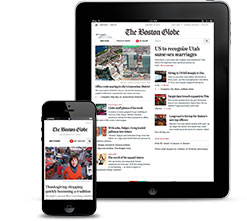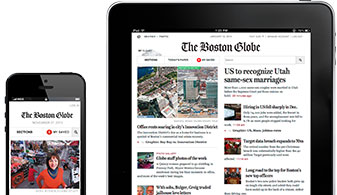After completing a video production internship in 2010, Igor Kharitonenkov set out to find a job in communications. He networked and sent out dozens of resumes, but got no response.
Then he tried a multimedia resume that used a QR code, the pattern of black-and-white squares that takes viewers to a website when scanned with a smartphone. With a few clicks, employers could check out his work history, letters of recommendation, and samples of his work, including a video about Bootstrap Compost, a Boston recycling firm, that he shot for his blog on sustainable businesses.
Jonathan Palumbo, director of external and government relations for the nonprofit-City Year Boston, was so impressed that he chose Kharitonenkov over more than 200 applicants for the position of communications coordinator.
“What made his resume really stand out was the use of the QR code,” Palumbo said. “It wasn’t the novelty of including the QR code, but rather the fact that it brought us directly to examples of projects he had completed with other organizations.”
Kharitonenkov, 25, left City Year in June to become vice president at Booststrap Compost — thanks in part to his video — and his success shows how multimedia resumes can help job seekers stand out in today’s ultracompetitive job market. With the explosion of social and mobile media that connect people with text, sound, photos, and video, multimedia resumes could be the wave of the future.
Although there are no precise statistics on the use of multimedia resumes, career specialists say they are seeing more of them. John Mee, president of Career Virtual, a Florida company that creates and supports multimedia career portfolios for executives, said it makes sense for many job candidates to use the full range of tools available in today’s interactive world.
He cited research that shows people remember 11 percent of what they read, 20 percent of what they hear, 27 percent of what they see, and 52 percent what they both hear and see. In other words, multimedia resumes are more memorable.
“It’s the same principle that color advertising works better than black and white," Mee said.
Anything more than plain text qualifies as a multimedia resume. Some use QR codes to transform a paper resume into an interactive document, while others are built online as websites.
New, do-it-yourself multimedia resume sites are springing up online, offering no and low-cost options. However for executives, an extensive digital portfolio that includes a brief biography, resume, list of references, and five to six work samples might be in order. Career Virtual, a division of Power Talent Network of Stuart, Fla., teams up with career coaches to develop Web portfolios for clients. Clients get secure, private websites that bring their accomplishments to life. For example, instead of a simple statement that an executive increased revenues by 25 percent, a digital portfolio might provide an animated graph.
Gia Fisher, an information technology executive in Los Angeles, is a case in point. After seeing her salary fall 60 percent as the small consulting firm where she worked lost clients, she decided it was time to move on. Career Virtual developed a digital portfolio for her, using animated charts and graphs to help her illustrate her accomplishments.
The portfolio helped her attract clients, and by November 2011, she had lined up enough to launch her own company, Atheria Consulting Group.
“I was using a traditional resume and getting results that were 40 to 50 percent,” said Fisher, who is in her late 40s. “The multimedia resume gave me 80 percent. I needed to attract a global clientele, and the portfolio was the catalyst to take my career to the next level.”
So, has the traditional resume become obsolete?
Not really, say career specialists. A sheet of paper remains easy to skim and simple to file — without the risk of technological glitches that could kill a job candidate’s chances. Further, some hiring managers worry that seeing a photo or video of an applicant could open them up to charges of discrimination.
Wendy Enelow, a resume-writing trainer and author based in Virginia, said multimedia resumes work best for certain fields such as graphic arts and Web design that involve “the latest and greatest” in technology. A cool multimedia resume can help tech-savvy candidates show off their skills.
Stand-alone video resumes have gotten mixed reviews. A 2010 survey by the Boston research firm Aberdeen Group found that only 5 percent of employers used video resumes in hiring.
Multimedia resumes work best when they are part of a broader campaign, said John Wilpers, founder and chief executive of Degrees2Dreams, which offers career-launching services to students and recent graduates. In addition to a multimedia resume, Wilpers said, such a campaign should include a blog about a niche in your professional field, personal marketing through social media, and a series of informational interviews.
“The multimedia resume has to be part of a more coherent strategy,” Wilpers says. “It’s like a tree falling in the woods. If nobody knows about it, what good is it?”
Fernando Febres, a 2012 graduate of Emerson College, was able to wow a prospective employer by combining traditional techniques, such as a paper resume and networking, with 21st-century technology. Febres designed his resume with his website address highlighted in an eye-catching blue and white banner to get reader attention. Anyone who decided to check out the site would see multimedia features such as photos of a logo he designed for a new line of high-fashion jeans and video clips of him interviewing people.
At a networking conference in New York, Febres said, recruiters commented on how his resume, business card, and website had a cohesive look. “It’s about branding me.” says Febres, 22, who landed a marketing job with General Mills, the Minneapolis-based food giant. “My advice to job seekers is to invest time online and in print.”













